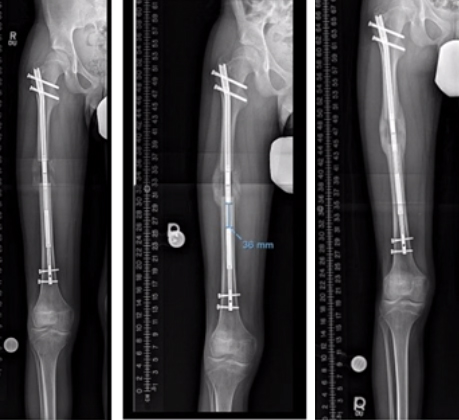
The practice of using an external device such as the Ilizarov apparatus is referred to as external leg lengthening. Through distraction osteogenes lengthening the bones and correcting deformities works by gradually growing new bone and soft tissues.

For patients who do not want to undergo shortening or epiphysiodesis for discrepancies less than 5 cm 2 in and in cases in which the discrepancy is greater than 5 cm 2 in limb lengthening is the procedure of choice to achieve leg length equalization.
Leg lengthening surgery adults. What is limb lengthening surgery. Limb lengthening is achieved using the bodys own capacity to regenerate new bone as well as the soft tissues ligaments blood vessels and nerves that surround and support it. The process begins with an operation called an osteotomy in which the orthopedic surgeon cuts the bone to be lengthened.
The limb usually the upper or lower leg. Leg lengthening surgery takes advantage of this capability of the bone and works by the surgeon cutting the bone and separating the two ends allowing new bone to grow in between lengthening the leg. This process is known as distraction osteogenesis.
Limb-lengthening can be carried out in the thigh femur or lower leg tibia. When a bone breaks it naturally regenerates to fix the fracture. Lengthening works by separating the bone and distracting pulling apart the bone segments very slowly so that new bone continues to form in the gap.
Read more about. Leg lengthening surgery pros and cons. Read more about.
Limb lengthening Surgery scar. A rule of thumb is that each 04 in 1 cm of lengthening requires some 36 days of healing. A large variety of external fixators are now available for use.
Todays fixators are very durable and are generally capable of holding full weight. A Due to vitamin D-resistant rickets which is a metabolic bone disease a deformity developed in both legs during growth age 16. B The Taylor Spatial Frame computer-assisted external fixator was used to perform a lengthening of the tibia and the femur which involved using a minimally invasive locking plate technique to assist the external fixator.
When is limb lengthening considered. For patients who do not want to undergo shortening or epiphysiodesis for discrepancies less than 5 cm 2 in and in cases in which the discrepancy is greater than 5 cm 2 in limb lengthening is the procedure of choice to achieve leg length equalization. Limb lengthening is a more complex and challenging procedure to.
Limb lengthening stimulates bone in a patients leg or arm to grow longer. We do this by surgically cutting the bone and attaching a device that slowly moves the two ends of the bone apart. Through distraction osteogenes lengthening the bones and correcting deformities works by gradually growing new bone and soft tissues.
Patients of short stature otherwise known as Dwarfism or achondroplasia may benefit from limb lengthening procedures. The procedures can lengthen both legs of patients in order to help patients grow taller. The leg-lengthening surgery is only recommended for short people with limb deformities.
You should be able to endure the surgery and the pain because you really want the surgery. The leg-lengthening surgery is an extremely long and painful procedure and the height increase that you gain is often not worth the time the cost and the pain. Leg lengthening surgery may allow patients to achieve their full height potential but external fixators require continual maintenance.
Internal fixators produce comparable results with fewer risks. Some leg length discrepancies may require special treatment but you and your surgeon can decide what treatment if any is best for you. Limb lengthening surgery was developed to help with leg straightening for children who were afflicted with growth abnormalities such as dwarfism and other deformities.
Now it has become a cosmetic surgery for adults who have tired of being below average in height. Surgery to become taller can be a life-changing experience. Limb Lengthening Service of the Hospital for Special Surgery.
Our surgeons offer surgical treatments for the correction of upper and lower limb deformities discrepancies and injuries in adults and children. We help individuals with orthopaedic issues due to trauma birth defects infections or bone tumors. Leg lengthening surgery is the procedure of choice to achieve equalization of limbs.
Extremely short limbs and bowed legs can make it difficult for those with dwarfism to perform daily tasks. Leg lengthening surgery not only can help straighten legs but also add the inches that will make daily routines easier. Limb lengthening surgery Acl surgery hamstring graft Circumcision surgery for adults Disclaimer.
The content is not intended to be a substitute for. The Ilizarov technique was a major breakthrough in limb lengthening as it allowed for the orthopedic surgeon to hold the bone in place during and after surgery to ensure correct alignment and encourage the growth of new bone. The practice of using an external device such as the Ilizarov apparatus is referred to as external leg lengthening.
Limb lengthening surgery surgery to get taller with more known name leg lengthening surgery or height surgery is a long-termed and hard surgery as well involving a 6-12 months treatment process. Limb lengthening is a reconstructive procedure where the deformed bone is straightened or missing bone is replaced. It is performed in children and adults who have variations in their leg length as a result of diseases injuries or birth defects.
Limb lengthening procedure can be performed by minimally invasive techniques and may require a hospitalization of 1-2 nights. Limb lengthening is a reconstructive procedure where the deformed bone is straightened or missing bone is replaced. It is performed in children and adults who have variations in their leg length because of diseases injuries or birth defects.
Limb lengthening procedure can be performed by minimally invasive techniques and may.